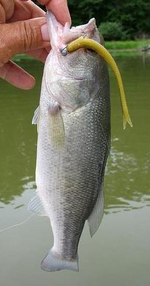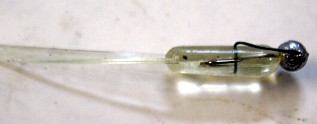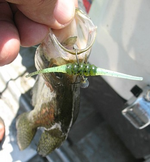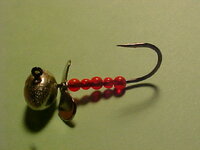SPOONMINNOW
Member
- Joined
- Oct 9, 2016
- Messages
- 265
Humans are attracted to, ignore, avoid and in some extreme cases - attack things, either by choice or involuntarily. (A few members on other forums make me want to attack them verbally with their sarcasm, but in most cases I resist the urge.) Fish are simple beings that are in the same boat (pun intended) as the humans that cast baits. Anglers attempt to initiate fish attacks - simple as that.
Live bait, obviously, is a tried & true way to fish that tops the list of ways to get fish to strike - even when the baits used are no way a part of a fish's diet or that even exist in the waters they live in. Examples are earthworms and centipedes. Why attack them? The answer is what this post is all about.
Fish have amazing senses that most anglers don't include in the reasons they chose lures. Granted, fish see baits but they also feel bait motions. Odor/scent is another but not from a distance. (Drop a bit of dye into the water and see how it stays in one spot as it spreads.) The lateral line completes the picture with fish watching with only one eye (forward vision being limited by head anatomy). In effect, fish see silhouettes of objects, leaving the lateral line to fill in the blanks as far as object thickness.
Do fish ever strike lures to eat them? Could be but not as plausible in my mind in that they are biologically formatted to attack various shapes and actions combined. Fishing lures are the most unnatural objects they will ever experience yet they attack them. examples?
How about the steady rotation of a brightly flashing, large willow-leaf blade on a spinnerbait along with its fluttering skirt? Only a human would imagine what a fish sees when confronted by that lure!
How about the steady flapping of a curl-tail Mr. Twister grub or Phenom worm curl tail, the latter bouncing off the bottom? Not too many animals bounce.
The same goes for a large Dardevel Spoon with its wild side-to-side swings and flips, a flashing chrome belly, and red & white striped back. Natural?
From those examples alone, the only conclusion I can come to is that fish don't see lures as anything but objects that move a certain way at a certain speed. I can't assume to know what fish are thinking much less their motive for attacking a lure. Hunger or the sudden urge to feed is not a helpful assumption leading to lure choice.
So why do fish attack certain moving objects, but not all moving objects? Finding lures fish attack is the primary goal and friction I think has a lot to do with it. The word friction has mainly two definitions: it occurs by rubbing two objects together; the other - a clash of temperaments.
Consider this: a lure is moving along minding its own business and out of nowhere - BAM! - it gets attacked. The lure clashes with the peaceful, quiet environment a fish hangs out in. No strobe-like flash; no on-the-surface swish/swish/swishing of a cigar-shaped object (Zara Spook); no fat wobbling tear-shaped plastic with bb's rattling around inside (fat-lipped crankbait). Yet fish get really p.o.'d when these lures intrude on their meditation. Let's just say that some fish have a very short temper and are intolerant of trespassers that flaunt their stuff.
The good thing about the above is the large number of lure actions + shapes that make fish attack for no reason other than, well - NO REASON WHATSOEVER, because that would require the ability to reason. As you've seen from the many photos I've posted of proven great fish catcher shapes and actions, all are different and most will catch fish in the same water on the same day. There's got to be something in a fish's brain DNA that once a lure is detected, a switch is flipped on either to attack it or let it pass. Lure design and how a lure is used is everything and a good thing: I sure as H wouldn't want to cast the same lure no matter how good day after day much less wait for live bait to get bit.
Don't shoot the author. It's a dreary cold day in the northeast with nothing to do. (Man do I wish jiggerjohn (John Mclean) was still alive! He loved to read my theories and we both loved putting them to the test.)
.
Live bait, obviously, is a tried & true way to fish that tops the list of ways to get fish to strike - even when the baits used are no way a part of a fish's diet or that even exist in the waters they live in. Examples are earthworms and centipedes. Why attack them? The answer is what this post is all about.
Fish have amazing senses that most anglers don't include in the reasons they chose lures. Granted, fish see baits but they also feel bait motions. Odor/scent is another but not from a distance. (Drop a bit of dye into the water and see how it stays in one spot as it spreads.) The lateral line completes the picture with fish watching with only one eye (forward vision being limited by head anatomy). In effect, fish see silhouettes of objects, leaving the lateral line to fill in the blanks as far as object thickness.
Do fish ever strike lures to eat them? Could be but not as plausible in my mind in that they are biologically formatted to attack various shapes and actions combined. Fishing lures are the most unnatural objects they will ever experience yet they attack them. examples?
How about the steady rotation of a brightly flashing, large willow-leaf blade on a spinnerbait along with its fluttering skirt? Only a human would imagine what a fish sees when confronted by that lure!
How about the steady flapping of a curl-tail Mr. Twister grub or Phenom worm curl tail, the latter bouncing off the bottom? Not too many animals bounce.
The same goes for a large Dardevel Spoon with its wild side-to-side swings and flips, a flashing chrome belly, and red & white striped back. Natural?
From those examples alone, the only conclusion I can come to is that fish don't see lures as anything but objects that move a certain way at a certain speed. I can't assume to know what fish are thinking much less their motive for attacking a lure. Hunger or the sudden urge to feed is not a helpful assumption leading to lure choice.
So why do fish attack certain moving objects, but not all moving objects? Finding lures fish attack is the primary goal and friction I think has a lot to do with it. The word friction has mainly two definitions: it occurs by rubbing two objects together; the other - a clash of temperaments.
Consider this: a lure is moving along minding its own business and out of nowhere - BAM! - it gets attacked. The lure clashes with the peaceful, quiet environment a fish hangs out in. No strobe-like flash; no on-the-surface swish/swish/swishing of a cigar-shaped object (Zara Spook); no fat wobbling tear-shaped plastic with bb's rattling around inside (fat-lipped crankbait). Yet fish get really p.o.'d when these lures intrude on their meditation. Let's just say that some fish have a very short temper and are intolerant of trespassers that flaunt their stuff.
The good thing about the above is the large number of lure actions + shapes that make fish attack for no reason other than, well - NO REASON WHATSOEVER, because that would require the ability to reason. As you've seen from the many photos I've posted of proven great fish catcher shapes and actions, all are different and most will catch fish in the same water on the same day. There's got to be something in a fish's brain DNA that once a lure is detected, a switch is flipped on either to attack it or let it pass. Lure design and how a lure is used is everything and a good thing: I sure as H wouldn't want to cast the same lure no matter how good day after day much less wait for live bait to get bit.
Don't shoot the author. It's a dreary cold day in the northeast with nothing to do. (Man do I wish jiggerjohn (John Mclean) was still alive! He loved to read my theories and we both loved putting them to the test.)
.






